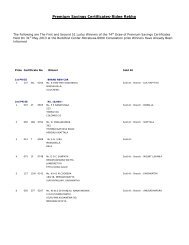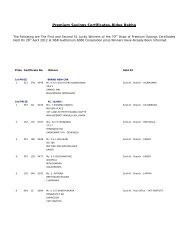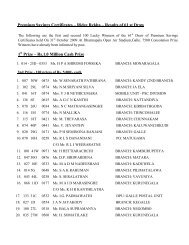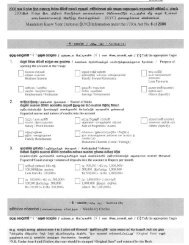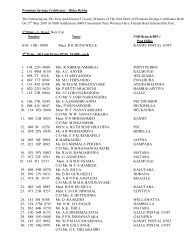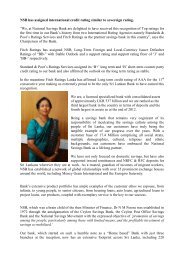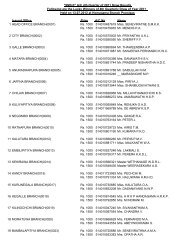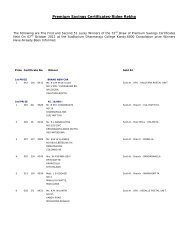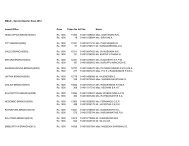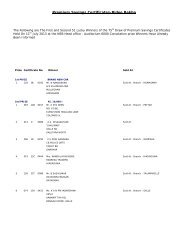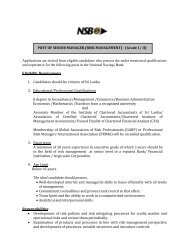Annual Report 2012 - National Savings Bank
Annual Report 2012 - National Savings Bank
Annual Report 2012 - National Savings Bank
You also want an ePaper? Increase the reach of your titles
YUMPU automatically turns print PDFs into web optimized ePapers that Google loves.
215THE RESULTS OF A CHALLENGING YEARNOTES TO THE FINANCIAL STATEMENTSconditions on which the historical lossexperience is based and to remove theeffect of conditions in the historical periodthat do not exist currently. Estimates ofchanges in future cash flows reflect, andare directionally consistent with, changesin related observable data from year toyear (such as changes in unemploymentrates, property prices, commodity prices,payment status, or other factors that areindicative of incurred losses in the groupand their magnitude). The methodologyand assumptions used for estimating futurecash flows are reviewed regularly to reduceany differences between loss estimatesand actual loss experience.iii. Available-for-sale financial investmentsFor available-for-sale financial investmentsincluding debt securities, the <strong>Bank</strong> assessesat each Statement of Financial Position datewhether there is objective evidence that aninvestment is impaired.In the case of debt instruments classifiedas available-for-sale, the <strong>Bank</strong> assessesindividually whether there is objectiveevidence of impairment based on thesame criteria as financial asset carried atamortized cost. However, the amountrecorded for impairment is the cumulativeloss measured as the difference betweenthe amortized cost and the current fairvalue, less any impairment loss on thatinvestment previously recognized in theIncome Statement. Future interest incomeis based on the reduced carrying amountand is accrued using the rate of interestused to discount the future cash flows forthe purpose of measuring the impairmentloss. The interest income is recorded aspart of ‘Interest and similar income’. If,in a subsequent period, the fair value of adebt instrument increased and the increasecan be objectively related to a credit eventoccurring after the impairment loss wasrecognized in the Income Statement, theimpairment loss is reversed through theIncome Statement.In the case of equity investments classified asavailable-for-sale, objective evidence wouldalso include a ‘significant’ or ‘prolonged’decline in the fair value of the investmentbelow its cost. The <strong>Bank</strong> treats ‘significant’generally as 20% and ‘prolonged’ generallyas greater than six months. Where thereis evidence of impairment, the cumulativeloss measured as the difference betweenthe acquisition cost and the current fairvalue, less any impairment loss on thatinvestment previously recognized in theIncome Statement is removed from equityand recognized in the Income Statement.Impairment losses on equity investmentsare not reversed through the IncomeStatement; increases in the fair valueafter impairment are recognized in othercomprehensive income.iv. Renegotiated loansWhere possible, the <strong>Bank</strong> seeks torestructure loans rather than to takepossession of collateral. This may involveextending the payment arrangements andthe agreement of new loan conditions.Once the terms have been renegotiated anyimpairment is measured using the originalEIR as calculated before the modification ofterms and the loan is no longer consideredpast due. Management continually reviewsrenegotiated loans to ensure that all criteriaare met and that future payments are likelyto occur. The loans continue to be subjectto an individual or collective impairmentassessment, calculated using the loan’soriginal EIR.2.3.3 Recognition of income and expensesfor financial instrumentsRevenue is recognized to the extent that itis probable that the economic benefits willflow to the <strong>Bank</strong> and the revenue can bereliably measured. The following specificrecognition criteria must also be met beforerevenue is recognized.i. Interest and similar income andexpenseFor all financial instruments measured atamortized cost, interest bearing financialassets classified as available-for-sale andfinancial instruments designated at fairvalue through profit or loss, interest incomeor expense is recorded using the EIR, whichis the rate that exactly discounts estimatedfuture cash payments or receipts throughthe expected life of the financial instrumentor a shorter period, where appropriate, tothe net carrying amount of the financialasset or financial liability. The calculationtakes into account all contractual termsof the financial instrument (for example,prepayment options) and includes anyfees or incremental costs that are directlyattributable to the instrument and are anintegral part of the EIR, but not future creditlosses.The carrying amount of the financial assetor financial liability is adjusted if the <strong>Bank</strong>revises its estimates of payments orreceipts. The adjusted carrying amount isNATIONAL SAVINGS BANK . ANNUAL REPORT <strong>2012</strong>



